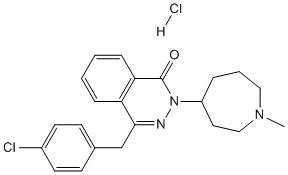All AbMole products are for research use only, cannot be used for human consumption.

Azelastine hydrochloride (Astelin) is a potent, second-generation, selective, histamine antagonist. Azelastine hydrochloride (Astelin) has a triple mode of action: Anti-histamine effect, mast-cell stabilizing effect and anti-inflammatory effect. Azelastine hydrochloride (Astelin) has a rapid onset of action: 15 minutes with the nasal spray and 3 minutes with the eye drops. The effect lasts for 12 hours.
| Molecular Weight | 418.36 |
| Formula | C22H24ClN3O.HCl |
| CAS Number | 79307-93-0 |
| Solubility (25°C) | DMSO 80 mg/mL |
| Storage |
Powder -20°C 3 years ; 4°C 2 years In solvent -80°C 6 months ; -20°C 1 month |
| Related Histamine Receptor Products |
|---|
| Dimethindene
Dimethindene is a potent, selective histamine H1 antagonist. |
| ABT-288
ABT-288 is a competitive, potent and selective histamine H3 receptor (H3R) antagonist. |
| A-349821
A-349821 is a histamine H3 receptor antagonist characterized as a radioligand ([3H]-A-349821) for in vivo receptor occupancy assessment. |
| Betazole
Betazole (Ametazole), a pyrazole analogue of histamine, is an orally active histamine H2 receptor agonist. |
| Tiotidine
Tiotidine (ICI 125211) is a potent and selective antagonist of histamine H2-receptor (pA2=7.3-7.8 for guinea-pig right atrium). |
All AbMole products are for research use only, cannot be used for human consumption or veterinary use. We do not provide products or services to individuals. Please comply with the intended use and do not use AbMole products for any other purpose.


Products are for research use only. Not for human use. We do not sell to patients.
© Copyright 2010-2024 AbMole BioScience. All Rights Reserved.
